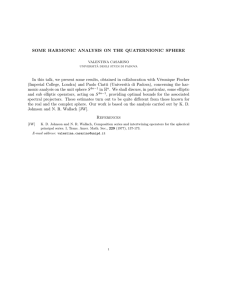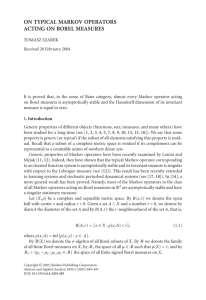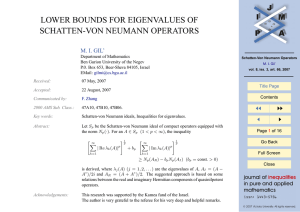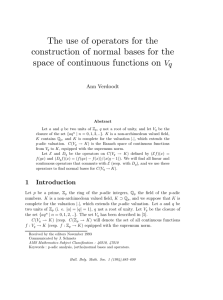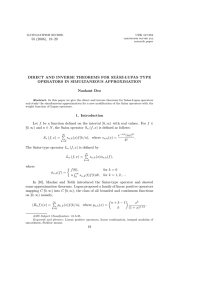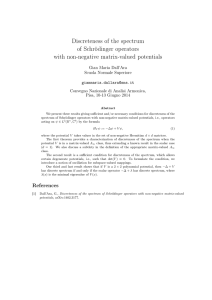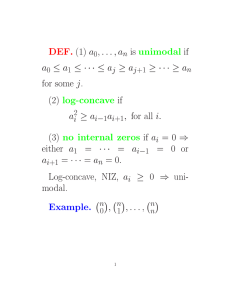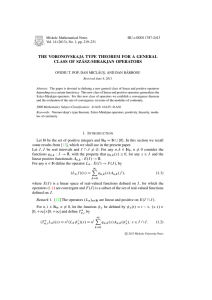PUBLICATIONS DE L’INSTITUT MATHÉMATIQUE Nouvelle série, tome 96 (110) (2014), 159–168
advertisement
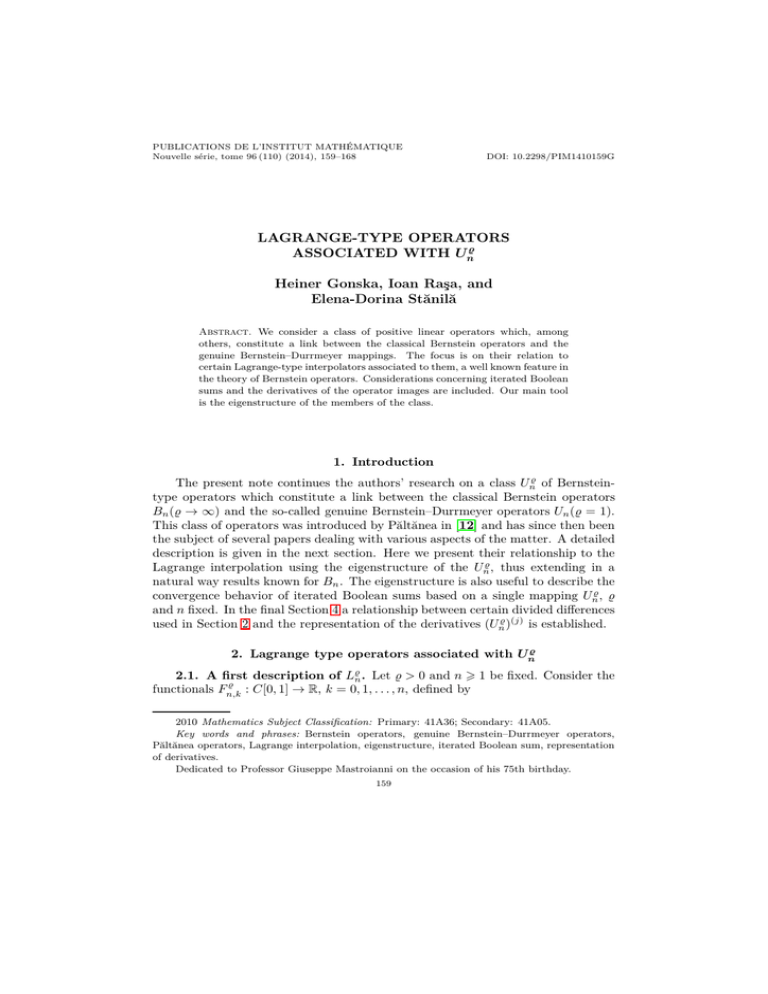
PUBLICATIONS DE L’INSTITUT MATHÉMATIQUE
Nouvelle série, tome 96 (110) (2014), 159–168
DOI: 10.2298/PIM1410159G
LAGRANGE-TYPE OPERATORS
ASSOCIATED WITH Un̺
Heiner Gonska, Ioan Raşa, and
Elena-Dorina Stănilă
Abstract. We consider a class of positive linear operators which, among
others, constitute a link between the classical Bernstein operators and the
genuine Bernstein–Durrmeyer mappings. The focus is on their relation to
certain Lagrange-type interpolators associated to them, a well known feature in
the theory of Bernstein operators. Considerations concerning iterated Boolean
sums and the derivatives of the operator images are included. Our main tool
is the eigenstructure of the members of the class.
1. Introduction
The present note continues the authors’ research on a class Un̺ of Bernsteintype operators which constitute a link between the classical Bernstein operators
Bn (̺ → ∞) and the so-called genuine Bernstein–Durrmeyer operators Un (̺ = 1).
This class of operators was introduced by Păltănea in [12] and has since then been
the subject of several papers dealing with various aspects of the matter. A detailed
description is given in the next section. Here we present their relationship to the
Lagrange interpolation using the eigenstructure of the Un̺ , thus extending in a
natural way results known for Bn . The eigenstructure is also useful to describe the
convergence behavior of iterated Boolean sums based on a single mapping Un̺ , ̺
and n fixed. In the final Section 4 a relationship between certain divided differences
used in Section 2 and the representation of the derivatives (Un̺ )(j) is established.
2. Lagrange type operators associated with Un̺
2.1. A first description of L̺n . Let ̺ > 0 and n > 1 be fixed. Consider the
̺
functionals Fn,k
: C[0, 1] → R, k = 0, 1, . . . , n, defined by
2010 Mathematics Subject Classification: Primary: 41A36; Secondary: 41A05.
Key words and phrases: Bernstein operators, genuine Bernstein–Durrmeyer operators,
Păltănea operators, Lagrange interpolation, eigenstructure, iterated Boolean sum, representation
of derivatives.
Dedicated to Professor Giuseppe Mastroianni on the occasion of his 75th birthday.
159
160
GONSKA, RAŞA, AND STĂNILĂ
̺
̺
Fn,0
(f ) = f (0), Fn,n−1
(f ) = f (1),
Z 1 k̺−1
t
(1 − t)(n−k)̺−1
̺
f (t) dt, k = 1, . . . , n − 1.
Fn,k
(f ) =
B(k̺, (n − k)̺)
0
The operator Un̺ : C[0, 1] → Πn (the space
polynomials of degree no
P of algebraic
̺
greater than n) is given by Un̺ (f ; x) := nk=0 Fn,k
(f )pn,k (x), f ∈ C[0, 1], where
pn,k (x) = nk xk (1 − x)n−k , x ∈ [0, 1]. With a slight abuse of notation consider
(n)
(n)
also the operator Un̺ : Πn → Πn . Its eigenvalues λn,k and eigenfunctions pn,k , k =
0, 1, . . . , n, are described in [4]; in particular,
(n)
(n)
(n)
(n)
1 = λ̺,0 = λ̺,1 > λ̺,2 > λ̺,3 > · · · > λ(n)
̺,n > 0,
which means that Un̺ : Πn → Πn is invertible. Consider the inverse operator
(Un̺ )−1 : Πn → Πn (note the domain of definition here!) and define L̺n : C[0, 1] →
Πn by
L̺n = (Un̺ )−1 ◦ Un̺ .
(2.1)
Then Un̺ (L̺n f ) = Un̺ (f ), f ∈ C[0, 1], which leads to
(2.2)
̺
̺
Fn,k
(L̺n f ) = Fn,k
(f ), f ∈ C[0, 1], k = 0, 1, . . . , n.
Relation (2.2) expresses an interpolatory property with respect to the functionals
̺
̺
Fn,0
, . . . , Fn,n
; more precisely, given f ∈ C[0, 1], L̺n f is the unique polynomial in
Πn satisfying (2.2). In particular, Ln p = p, for all p ∈ Πn . It is known [3] that
(2.3)
̺
lim Fn,k
(f ) = f (k/n), f ∈ C[0, 1], k = 0, 1, . . . , n.
̺→∞
This entails
lim Un̺ (f ) = Bn f, uniformly on [0, 1],
(2.4)
̺→∞
for all f ∈ C[0, 1]; here Bn denotes the classical Bernstein operator on C[0, 1]. Let
Ln be the Lagrange operator on C[0, 1] based on the nodes 0, n1 , . . . , n−1
n , 1. It is
easy to see that
Ln = Bn−1 ◦ Bn ,
(2.5)
B
(Bn )−1
n
where C[0, 1] −−−
→ Πn −−−−−→ Πn . Similar to the above, the symbol (Bn )−1 means
the inverse of Bn : Πn → Πn . We will see that
(2.6)
lim L̺n (f ) = Ln f, uniformly on [0, 1],
̺→∞
for all f ∈ C[0, 1]. If we interpret (2.4) by saying that Un∞ = Bn , then (2.6) can be
interpreted as L∞
n = Ln . On the other hand, one has (see [4, (3.3)])
(2.7)
Un̺ f =
n
X
k=0
(n) (n) (n)
λ̺,k p̺,k µ̺,k (f ), f ∈ C[0, 1],
̺
LAGRANGE-TYPE OPERATORS ASSOCIATED WITH Un
(n)
161
(n)
where µ̺,k are the dual functionals of p̺,k . This leads to
L̺n (f ) = (Un̺ )−1 (Un̺ f ) =
n
X
(n)
λ̺,k
k=0
L̺n (f ) =
(2.8)
n
X
1 (n) (n)
p µ (f ),
(n) ̺,k ̺,k
λ̺,k
i.e.,
(n) (n)
p̺,k µ̺,k (f ), f ∈ C[0, 1].
k=0
Un̺
and L̺n , expressed by (2.7) and (2.8), is similar to
So the relationship between
the relationship between Bn = Un∞ and Ln = L∞
n , described in [1, Sect. 6].
To conclude this section let us recall that Un̺ = Bn ◦ Bn̺ where
x = 0;
f (0),
Z 1
1
Br (f ; x) =
trx−1 (1 − t)r−rx−1 f (t) dt, 0 < x < 1;
B(rx, r − rx) 0
f (1),
x = 1.
is the Lupaş–Mühlbach Beta operator (see [7, p. 63], [11]). From (2.1) and (2.5) it
follows
L̺n = (Bn̺ )−1 ◦ Ln ◦ Bn̺ , ̺ > 0,
(2.9)
i.e., the operators L̺n and Ln are similar.
2.2. A concrete approach to L̺n . In order to obtain other representations
of the operators L̺n we shall use a classical method described, for example, in [13,
Sect. 1.2], [2], [8, Sect. 1.3]. Let n > 1, ̺ > 0 and f ∈ C[0, 1] be fixed. Then
L̺n f ∈ Πn has the form L̺n f = c0 e0 + c1 e1 + · · · + cn en , where ej (x) = xj , x ∈ [0, 1],
j > 0, and cj ∈ R. According to (2.2), the coefficients c0 , . . . , cn satisfy the system
of equations
L̺n f = c0 e0 + c1 e1 + · · · + cn en
̺
̺
̺
̺
Fn,0
(f ) = c0 Fn,0
(e0 ) + c1 Fn,0
(e1 ) + · · · + cn Fn,0
(en )
...
̺
̺
̺
̺
Fn,n
(f ) = c0 Fn,n
(e0 ) + c1 Fn,n
(e1 ) + · · · + cn Fn,n
(en ).
By eliminating c0 , . . . , cn , we get
̺
Ln f
e0
̺
̺
Fn,0 (f ) Fn,0
(e0 )
(2.10)
...
.
.
.
̺
̺
Fn,n (f ) Fn,n
(e0 )
e1
̺
Fn,0
(e1 )
...
̺
Fn,n
(e1 )
...
...
...
...
en ̺
Fn,0
(en ) =0
. . . ̺
Fn,n
(en )
̺
Since Fn,j
(em ) = (i̺)m /(n̺)m , where by xk = x(x + 1) · · · · · (x + k − 1) we have
denoted the rising factorial, from (2.10) we get after elementary computations
162
GONSKA, RAŞA, AND STĂNILĂ
(2.11)
0
e0
̺
Fn,0 (f ) 1
1
−1 n−1
̺
,1
Ln f = −V 0, , . . . ,
̺
Fn,1 (f ) 1
n
n
...
...
F ̺ (f ) 1
n,n
(n̺)1̄
e1
(n̺)
(0̺)1̄
(n̺)
(1̺)1̄
(n̺)
...
(n̺)1̄
(n̺)
...
...
...
...
...
(n̺)n̄ en
(n̺)n (0̺)n̄ (n̺)n n̄ (1̺)
(n̺)n ... (n̺)n̄ (n̺)n where V is the Vandermonde determinant. Now we are in the position to prove (2.6).
Theorem 2.1. For each f ∈ C[0, 1] we have
lim L̺n f = Ln f, uniformly on [0, 1].
̺→∞
Proof. Let us remark that
(2.12)
j k
(j̺)k̄
=
.
̺→∞ (n̺)k
n
lim
From (2.3), (2.11), and (2.12) we deduce
(2.13)
0
e0
f (0)
1
1
n − 1 −1 f ( n1 )
1
̺
lim L f = −V 0, , . . . ,
,1
...
...
̺→∞ n
n
n
n−1
f (
1
n )
f (1)
1
e1
0
1
n
...
n−1
n
1
...
...
...
...
...
...
en 0 1 n (n) .
. . . n
( n−1
n ) 1 Since the right-hand side of (2.13) is Ln f (see, e.g., [15, Sect. 3.1], [8, Sect. 1.3]),
the proof is complete.
2.3. The associated divided difference. The coefficient of en in the expression of Ln f is the divided difference of f at the nodes 0, n1 , . . . , n−1
n , 1, and is
given by (see e.g. [15, Sect. 2.6]):
(2.14)
h 1
i
1
n−1
n − 1 −1
0, , . . . ,
, 1; f = V 0, , . . . ,
,1
n
n
n
n
1
0
0
...
1
1 2
1
(
)
...
n
n
...
...
× . . . . . .
n−1
n−1 2
1
(
)
.
..
n
n
1
1
1
...
0
( n1 )n−1
...
n−1
( n−1
n )
1
̺
̺
̺
Let us denote by [Fn,0
, Fn,1
, . . . , Fn,n
; f ] the coefficient of en in L̺n f .
f (0) f ( n1 ) . . . .
f ( n−1
n )
f (1) ̺
LAGRANGE-TYPE OPERATORS ASSOCIATED WITH Un
Theorem 2.2. For each f ∈ C[0, 1] we have
n − 1 −1
(n̺)n̄ 1
̺
̺
̺
V
0,
,
.
.
.
,
,1
(2.15) [Fn,0
, Fn,1
, . . . , Fn,n
; f] =
(n̺)n
n
n
1
0
0
...
0
1
1 2
1 n−1
1
(
)
.
.
.
(
)
n
n
n
× . . . . . .
...
...
...
n−1 2
n−1 n−1
n−1
1
(
)
.
.
.
(
n
n
n )
1
1
1
...
1
Proof. From (2.11) we get immediately
163
̺
Fn,0
(f ) ̺
Fn,1
(f ) .
...
̺
Fn,n−1
(f )
F ̺ (f ) n,n
̺
̺
̺
[Fn,0
, Fn,1
, . . . , Fn,n
; f]
(0̺)1̄
1
n̺
1̄
−1 (1̺)
n̄
(n̺)
1
n−1
1
=
V 0, , . . . ,
,1
n̺
(n̺)n
n
n
. . .
...
(n̺)1̄
1
n̺
1 (0̺)1̄
(n̺)n̄ /(n̺)n
1 (1̺)1̄
=
n(n−1)
1
n−1
...
(n̺) 2 V 0, n , . . . , n , 1 . . .
1 (n̺)1̄
1
0
1
(n̺)n̄ /(n̺)n
̺
=
. . . . . .
n(n−1)
(n̺) 2 V 0, n1 , . . . , n−1
,
1
n
1
n̺
...
...
...
...
(0̺)n−1
(n̺)n−1
(1̺)n−1
(n̺)n−1
...
(n̺)n−1
(n̺)n−1
...
...
...
...
(0̺)n−1
(1̺)n−1
...
(n̺)n−1
...
...
...
...
0
̺n−1
...
(n̺)n−1
and this leads to (2.15).
̺
Fn,0
(f ) ̺
Fn,1
(f ) ... ̺
Fn,n
(f )
̺
Fn,0
(f ) ̺
Fn,1
(f ) ... ̺
Fn,n
(f )
̺
Fn,0
(f ) ̺
Fn,1
(f ) . . . F ̺ (f )
n,n
Remark 2.1. From (2.3), (2.14) and (2.15) we derive
h 1
i
n−1
̺
̺
̺
lim [Fn,0
, Fn,1
, . . . , Fn,n
; f ] = 0, , . . . ,
, 1; f
̺→∞
n
n
for all f ∈ C[0, 1]. Moreover, let f ∈ C[0, 1] and Φn a (Lagrange type) polynomial
̺
with Φn ∈ Πn , Φn ( nj ) = Fn,j
(f ), j = 0, . . . , n. From (2.14) and (2.15) it is easy to
deduce
i
(n̺)n̄ h 1
n−1
̺
̺
̺
[Fn,0
, Fn,1
, . . . , Fn,n
; f] =
0,
,
.
.
.
,
,
1;
Φ
.
n
(n̺)n
n
n
The last (classical) divided difference can be computed by recurrence; see [15].
Remark 2.2. Using (2.8), we see that
(2.16)
̺
̺
̺
µ(n)
̺,n = [Fn,0 , Fn,1 , . . . , Fn,n ; ·].
For the Bernstein operator (i.e., for ̺ → ∞), (2.16) can be found in [1, p. 164] .
164
GONSKA, RAŞA, AND STĂNILĂ
Remark 2.3. u̺n+1 := en+1 − L̺n en+1 is the unique monic polynomial in Πn+1
n−1
1
such that L̺n u̺n+1 = 0. For example, u∞
n+1 = x(x − 1)(x − n ) · · · · · (x − n ).
1
Moreover, un+1 (x) = x(x − 1)Jn−1 (x), where J0 (x), J1 (x), . . . are the monic Jacobi
polynomials, orthogonal on [0, 1] with respect to the weight function x(1 − x).
1
1
Indeed, Fn,0
(u1n+1 ) = Fn,n
(u1n+1 ) = 0, and
Z 1
Z 1
tk−1 (1 − t)n−k−1 u1n+1 (t) dt =
tk−1 (1 − t)n−k−1 t(t − 1)Jn−1 (t) dt = 0
0
0
(since for all k = 1, . . . , n − 1, tk−1 (1 − t)n−k−1 is a polynomial of degree n − 2).
1
This implies Fn,k
(u1n+1 ) = 0, k = 1, . . . , n − 1, and so L1n (u1n+1 ) = 0. For general
values of ̺ we have not found such compact representations.
Now we shall prove a general result.
Theorem 2.3. The polynomial u̺n+1 has n + 1 distinct roots in [0, 1].
−1
Proof. By using Remark 2.3 and (2.9) we get (Bn̺ ◦ Ln ◦ Bn̺ )(u̺n+1 ) = 0,
which entails Ln (Bn̺ u̺n+1 ) = 0. Now the same Remark 2.3 yields
Bn̺ u̺n+1 =
(n̺)n+1
(n̺)n+1
u∞
n+1 .
So Bn̺ u̺n+1 has n + 1 distinct roots in [0, 1]. According to [6], u̺n+1 has at least
n + 1 distinct roots in [0, 1]; to finish the proof, it suffices to remark that u̺n+1 is a
polynomial of degree n + 1.
Now let us recall the representation of Ln in terms of the fundamental Lagrange
polynomials:
n
k
X
, f ∈ C[0, 1], x ∈ [0, 1].
Ln f (x) =
ln,k (x)f
n
k=0
Using (2.9) we infer that L̺n has a similar representation, namely
L̺n f (x) =
n
X
̺
̺
ln,k
(x)Fn,k
(f ),
k=0
where
(2.17)
−1
̺
ln,k
:= Bn̺ (ln,k ), k = 0, 1, . . . , n.
̺
Theorem 2.4. For each k = 0, 1, . . . , n, the polynomial ln,k
has n distinct roots
in [0, 1].
̺
Proof. Since, according to (2.17), Bn̺ (ln,k
) = ln,k , the proof is similar to that
of Theorem 2.3 and we omit it.
In what follows we shall establish mean value theorems for the generalized
divided difference and for the remainder Rn̺ f := f − L̺n .
̺
LAGRANGE-TYPE OPERATORS ASSOCIATED WITH Un
165
Theorem 2.5. Let n > 1, ̺ > 0 and f ∈ C[0, 1] be given. Then there exist
0 = t0 < t1 < · · · < tn = 1 such that
Rn̺ f (ti ) = 0, i = 0, 1, . . . , n.
(2.18)
̺
Proof. According to (2.2), Fn,k
(Rn̺ f ) = 0, k = 0, 1, . . . , n, i.e.
Rn̺ f (0) = Rn̺ f (1) = 0,
(2.19)
(2.20)
Set x :=
(2.21)
Z
1
0
̺
t
1−t ,
Z
tk̺−1 (1 − t)(n−k)̺−1 Rn̺ f (t) dt = 0, k = 1, . . . , n − 1.
j := k − 1, and h(x) := Rn̺ f
∞
x1/̺
1+x1/̺
, x > 0. Then (2.20) becomes
(1 + x1/̺ )−n̺ xj h(x) dx = 0, j = 0, 1, . . . , n − 2.
0
Suppose that the number of the roots of h in (0, +∞) is at most n − 2, i.e.,
{x ∈ (0, +∞) : h(x) = 0} = {x1 , . . . , xr }, r 6 n − 2.
Then there exists a polynomial p ∈ Πn−2 such that {x ∈ (0, +∞) : p(x) = 0} ⊂
{x1 , . . . , xr } and, moreover,
Z ∞
(2.22)
(1 + x1/̺ )−n̺ p(x)h(x) dx > 0.
0
Obviously (2.22) contradicts (2.21), which means that h has at least n − 1 roots
in (0, +∞). It follows that Rn̺ f has at least n − 1 roots in (0, 1). Together with
(2.19), this proves the theorem.
Corollary 2.1. Let n > 1, ̺ > 0 and f ∈ C n [0, 1] be given. Then there exists
ξ ∈ (0, 1) such that
f (n) (ξ)
̺
̺
̺
; f] =
[Fn,0
, Fn,1
, . . . , Fn,n
.
n!
Proof. According to Theorem 2.5, Rn̺ f has at least n + 1 roots in [0, 1]. It
follows that (Rn̺ f )(n) has at least a root ξ ∈ (0, 1). Thus
̺
̺
̺
0 = (Rn̺ f )(n) (ξ) = f (n) (ξ) − n![Fn,0
, Fn,1
, . . . , Fn,n
; f ],
and the proof is finished.
Let now n > 1, ̺ > 0 and f ∈ C n+1 [0, 1] be given. Consider the points
t0 , t1 , . . . , tn satisfying (2.18), and let ω(t) = (t − t0 ) · · · (t − tn ).
Corollary 2.2. Let x ∈ [0, 1] r {t0 , t1 , . . . , tn }. Under the above assumption
there exists ηx ∈ (0, 1) such that
Rn̺ f (x) = ω(x)
f (n+1) (ηx )
.
(n + 1)!
Proof. Consider the function w(t) = ω(x)Rn̺ f (t) − ω(t)Rn̺ f (x), t ∈ [0, 1].
Then x, t0 , . . . , tn are roots of w, which means that there exists ηx ∈ (0, 1) such
that w(n+1) (ηx ) = 0. Now it suffices to remark that w(n+1) (t) = ω(x)f (n+1) (t) −
(n + 1)!Rn̺ f (x).
166
GONSKA, RAŞA, AND STĂNILĂ
Corollaries 2.1 and 2.2 generalize the mean value theorems for the divided difference and the remainder in the classical Lagrange interpolation; see [15, Sect. 3.1],
[8, Sect. 1.4]..
3. Iterated Boolean sums of the operators Un̺
LM ̺
For M > 1, let
Un = I − (I − Un̺ )M be the iterated Boolean sum of
̺
Un ; here I stands for the identity operator on C[0, 1]. Iterated Boolean sums of
the classical Bernstein operator and modifications thereof were investigated by numerous authors in the past, among them Mastroiani and Occorsio [9, 10]. Some
historical information on this method which may be traced to Natanson can be
found in [5]. From a general result of Wenz [16, Theorem 2] it follows that
LM ̺
limM→∞
Un f = L̺n f , f ∈ C[0, 1], n > 1. With the notation from the preceding sections, we can say more, namely
Theorem 3.1. Let n > 2 and f ∈ C[0, 1] be given. Then
MM
̺
̺
̺
−M
Un̺ f − L̺n f = −[Fn,0
, Fn,1
, . . . , Fn,n
; f ]p(n)
(3.1)
lim (1 − λ(n)
̺,n ,
̺,n )
M→∞
uniformly on [0, 1].
Proof. We have, according to (2.7)
MM
M
M X
Un̺ f = I − (I − Un̺ )M f =
(−1)i+1
(Un̺ )i f
i
i=1
=
M
X
(−1)i+1
i=1
=
=
n
X
k=0
n
X
n
M X
(n) (n)
i
p̺,k µ̺,k (f )
k=0
M
X
(n) i (n) (n)
λ̺,k p̺,k µ̺,k (f )
(−1)i+1
i=1
(n) (n)
M i
(n) M p̺,k µ̺,k (f ) 1 − 1 − λ̺,k
k=0
(n) i
λ̺,k
.
Combined with (2.8) this yields
n
MM
X
(n) (n)
(n) M
̺
̺
Un f − L n f = −
p̺,k µ̺,k (f ) 1 − λ̺,k ,
i.e.,
k=0
−M
1 − λ(n)
̺,n
MM
Un̺ f − L̺n f
=
(n)
−p(n)
̺,n µ̺,n (f )−
n−1
X
(n)
(n)
µ̺,k (f )µ̺,k (f )
k=0
(n) (n) Since 0 < 1 − λ̺,k / 1 − λ̺,n < 1, k = 0, . . . , n − 1, we get
−M MM ̺
̺
(n)
lim 1 − λ(n)
U
f
−
L
f
= −µ(n)
̺,n
n
n
̺,n (f )p̺,n .
(n) M
1 − λ̺,k
(n)
1 − λ̺,n
.
M→∞
To conclude the proof it suffices to use (2.16).
Remark 3.1. For ̺ → ∞, (3.1) was obtained in [14, Th. 26.7].
̺
LAGRANGE-TYPE OPERATORS ASSOCIATED WITH Un
167
4. The derivatives of Un̺
In this section we show that there is a natural relationship between the derivatives of the operator images and the divided differences [. . . ; Φn ] which we introduced in Remark 2.1.
Theorem 4.1. With the usual notation the following relationships hold
n−1
n−1
hk k + 1
i
X
X
̺
(i)
(Un̺ (f ; x))′ = n
pn−1,k (x)∆1 Fn,k
(f ) =
pn−1,k (x) ,
; Φn ;
n
n
k=0
k=0
(ii) (Un̺ (f ; x))(j) = n(n − 1) · · · (n − j + 1)
n−j
X
̺
pn−j,k (x)∆j Fn,k
(f )
= n(n − 1) · · · (n − j + 1)
n−j
X
pn−j,k (x)
k=0
k=0
i
j! h k
k+j
,
.
.
.
,
;
Φ
;
n
nj n
n
n n i
X
X
n
n k! h 1
k
̺
(iii)
Un̺ (f ; x) =
∆k Fn,0
(f )ek (x) =
0,
,
.
.
.
,
;
Φ
n ek (x);
k
k nk
n
n
k=0
k=0
̺
(f ).
where as before Φn nk = Fn,k
Proof. (i) The forward difference was defined in [3, p. 792] by
j
∆
̺
Fn,k
(f )
=
j X
j
i=0
i
̺
(−1)i+j Fn,k+i
(f ).
Thus we have
hk k + 1
i Φ ( k+1 ) − Φ ( k )
̺
n n
n n
̺
̺
= n Fn,k+1
(f ) − Fn,k
(f ) = n∆1 Fn,k
(f );
,
; Φn =
k+1
k
n
n
−
n
n
(ii) The first equality can be found in [3, p. 792]. It remains to show that
i
j! h k
k+j
̺
∆j Fn,k
(f ) = j
,...,
; Φn .
n n
n
̺
j+1 ̺
j ̺
j ̺
We have that ∆ Fn,k (f ) = ∆(∆ Fn,k (f )) = ∆ Fn,k+1 (f ) − ∆j Fn,k
(f ). By using
the recurrence formula for divided differences (see e.g. [15, p.104]) we get
k+j+1
; Φn − nk , . . . , k+j
j! j + 1 k+1
j ̺
j ̺
n ,...,
n
n ; Φn
∆ Fn,k+1 (f ) − ∆ Fn,k (f ) = j ·
·
k+j+1
n
n
− nk
n
i
(j + 1)! h k
k+j+1
̺
(f ),
=
,...,
; Φn = ∆j+1 Fn,k
j+1
n
n
n
n
X
(Un̺ f )(j) (0) k
Un̺ (f ; x) =
x
j!
j=0
̺
and show that (Un̺ (f ; x))(j) = n(n − 1) · · · (n − j + 1)∆j Fn,0
(f ).
To this end we take x = 0 in (ii); because pn−j,0 (0) = 1 and for all k > 1,
Pn−j
pn−j,k (0) = 0, from k=0 only the first term remains, which concludes the proof.
168
GONSKA, RAŞA, AND STĂNILĂ
Remark 4.1. In the case ̺ → ∞ we can find the analogues of the above
relationships in [15, pp. 300–302].
References
1. S. Cooper, S. Waldron, The eigenstructure of the Bernstein operator, J. Approx. Theory 105
(2000), 133–165.
2. P. J. Davis, Interpolation and Approximation, Dover, New York, 1975.
3. H. Gonska, R. Păltănea, Simultaneous approximation by a class of Bernstein-Durrmeyer
operators preserving linear functions, Czechoslovak Math. J. 60 (2010), 783–799.
4. H. Gonska, I. Raşa, E.D. Stănilă, The eigenstructure of operators linking the Bernstein and
the genuine Bernstein-Durrmeyer operators, Mediterr. J. Math. (2013), DOI: 10.1007/s00009013-0347-0
5. H. Gonska, X.-L. Zhou, Approximation theorems for the iterated Boolean sums of Bernstein
operators, J. Comput. Appl. Math. 53 (1994), 21–31.
6. D. Kacsó, E. D. Stănilă, On the class of operators Un̺ linking the Bernstein and the genuine
Bernstein-Durrmeyer operators, J. Appl. Funct. Anal. 9 (2014), 335–348.
7. A. Lupaş, Die Folge der Betaoperatoren, Ph.D. Thesis, Stuttgart: Universität Stuttgart 1972.
8. G. Mastroianni, G. V. Milovanović, Interpolation Processes. Basic Theory and Applications,
Springer, 2008.
9. G. Mastroianni, M. R. Occorsio, Una generalizzazione dell’operatore di Bernstein, Rend. Accad. Sci. Mat. Fis. Nat. Napoli, Serie IV, 44 (1977), 151–169.
, Una generalizzazione dell’operatore di Stancu, Rend. Accad. Sci. Mat. Fis. Mat.
10.
Napoli, Serie IV, 45 (1978), 495–511.
11. G. Mühlbach, Rekursionsformeln für die zentralen Momente der Pólya und der BetaVerteilung, Metrika 19 (1972), 171–177.
12. R. Păltănea, A class of Durrmeyer type operators preserving linear functions, Ann. Tiberiu
Popoviciu Sem. Funct. Equat. Approxim. Convex. (Cluj-Napoca) 5 (2007), 109–117.
13. E. Popoviciu, Teoreme de Medie din Analiza Matematică şi Legatura lor cu Teoria Interpolării, Editura Dacia, Cluj, 1972.
14. I. Raşa, T. Vladislav, Analiza Numerică. Aproximare, problema lui Cauchy abstractă, proiectori Altomare, Ed. Tehnica, Bucureşti 1999.
15. D. D. Stancu, O. Agratini, Gh. Coman, R. Trâmbiţaş, Analiză Numerică şi Teoria Aproximării, vol. I, Cluj-Napoca: Presa Universitară Clujeană 2001.
16. H. J. Wenz, On the limits of (linear combinations of) iterates of linear operators, J. Approx.
Theory 89 (1997), 219–237.
University of Duisburg-Essen
Faculty of Mathematics
Forsthausweg 2
47057 Duisburg
Germany
heiner.gonska@uni-due.de
elena.stanila@stud.uni-due.de
Technical University of Cluj-Napoca
Department of Mathematics
Str. Memorandumului nr. 28
RO-400114 Cluj-Napoca
Romania
Ioan.Rasa@math.utcluj.ro
